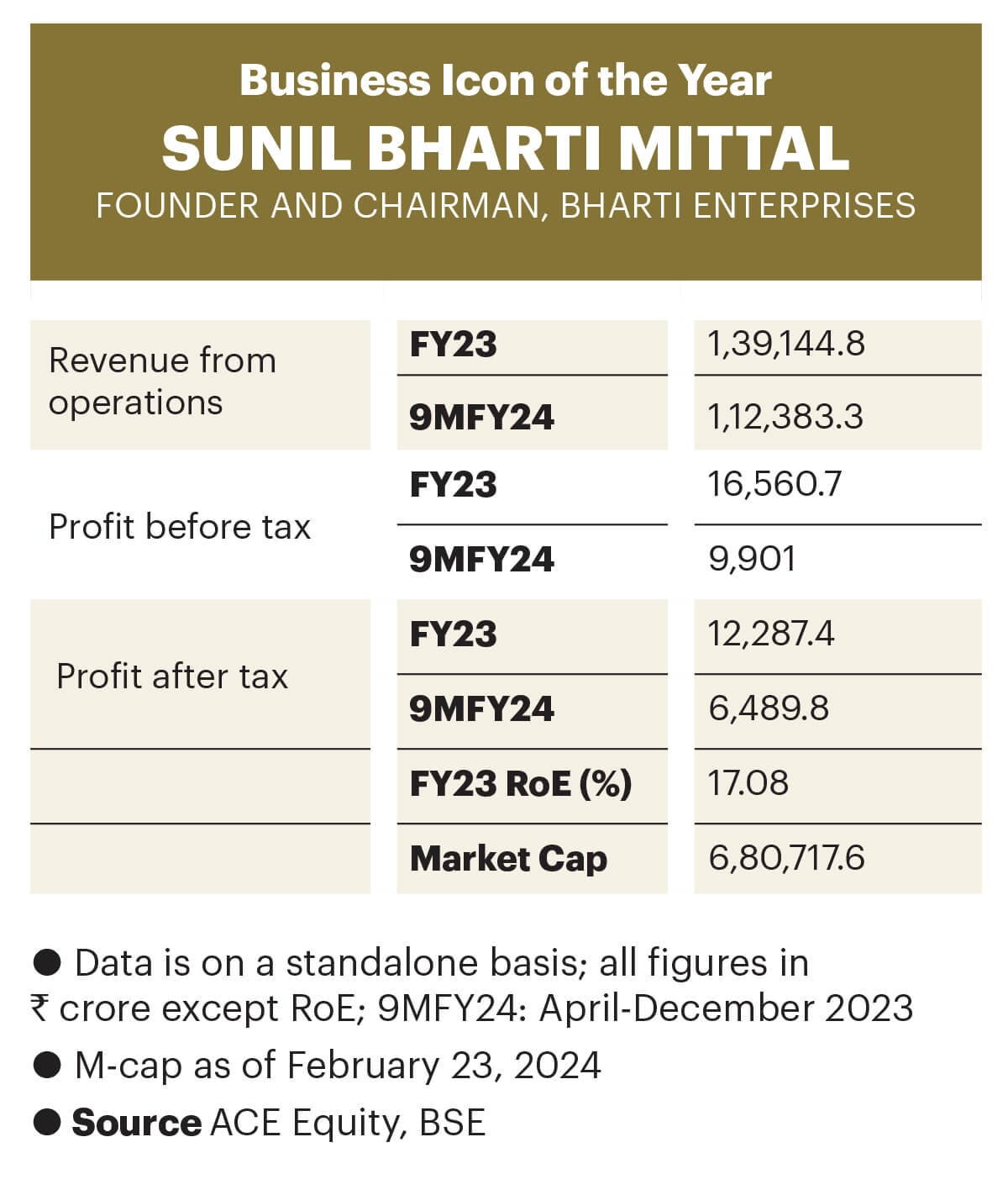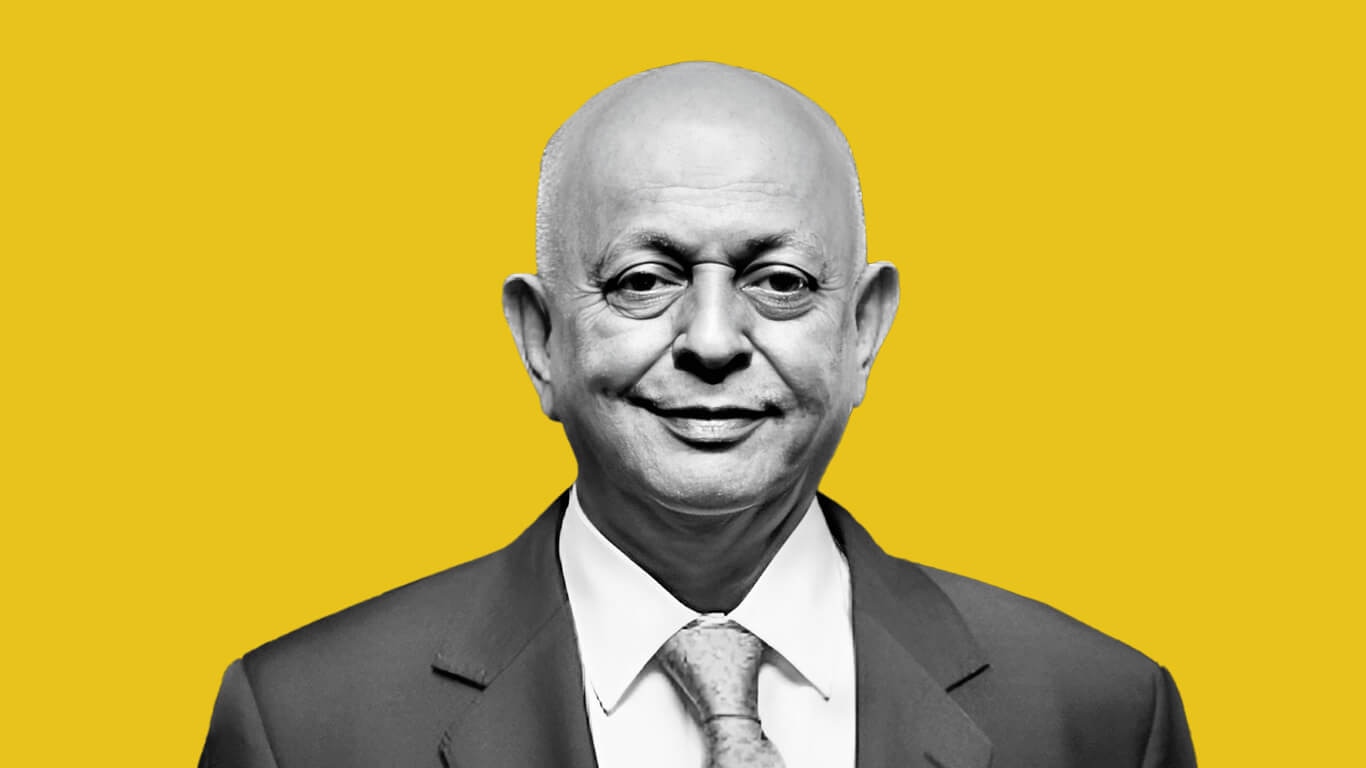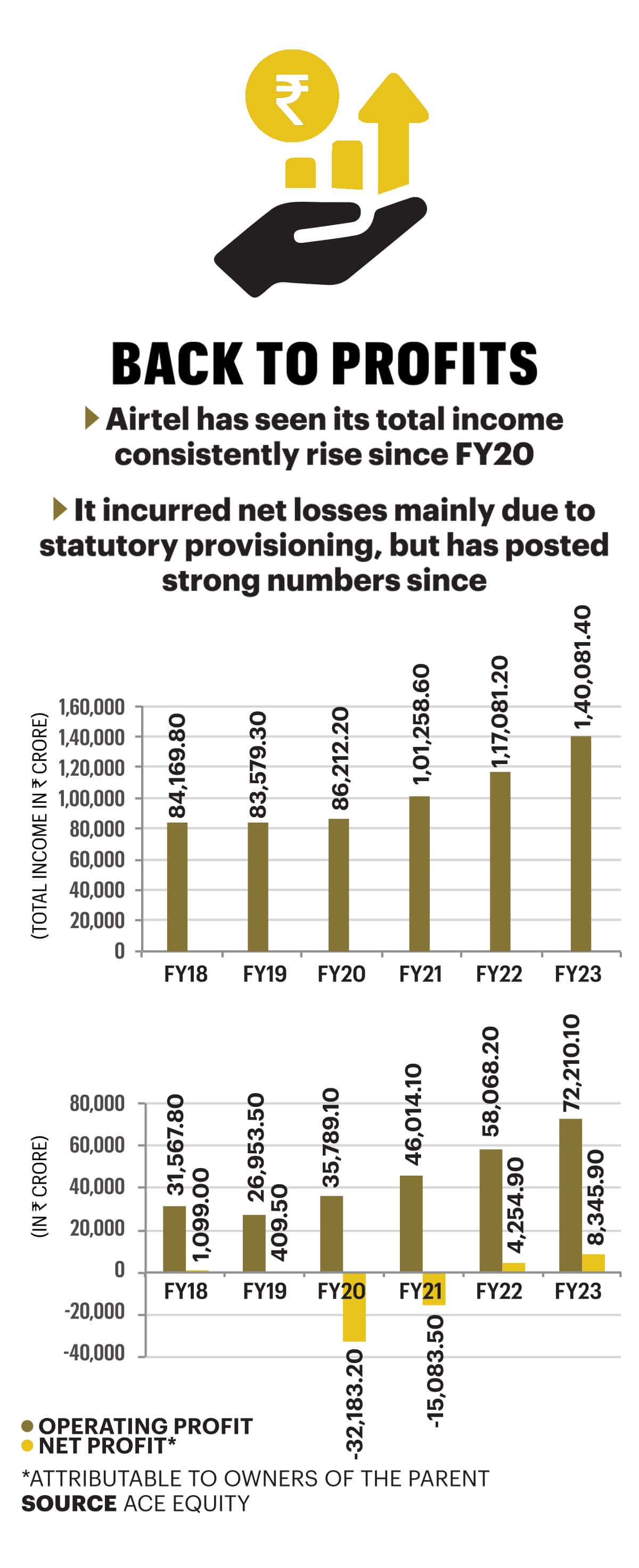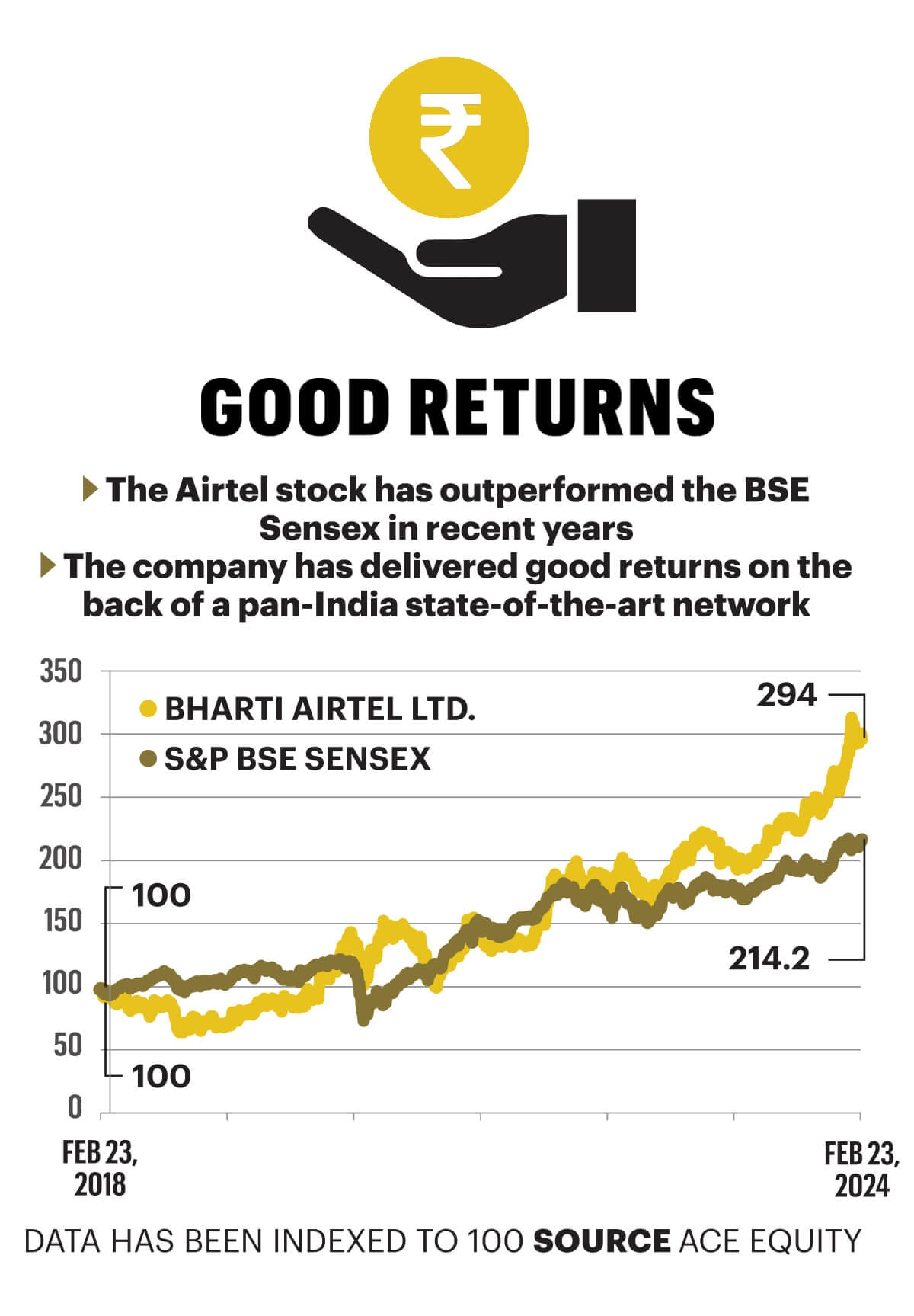
We don't support landscape mode yet. Please go back to portrait mode for the best experience
Sunil Bharti Mittal has spent a lifetime in telecom, creating a mammoth called Bharti Airtel. Now, he is backing OneWeb for a higher trajectory
(Photos: Bandeep Singh)

Airtel's Sunil Bharti Mittal is the Business Icon of the Year (Photo: Bandeep Singh)
Sunil Bharti Mittal admits to not being the best person to lead a company in peaceful and good times. “That is why I leave it to people like Gopal [Vittal, MD & CEO, Bharti Airtel] to do that. But when there is a crisis, you’ll find me right in the center of action because I can bring a lot of stability,” he says. Look back at the growth of Mittal’s telecom business, and you note that the Founder and Chairman of Bharti Enterprises has weathered many storms, including regulatory regimes, cut-price competition, and quicksands in Africa.
Mittal—whom the jury that decided the BT-PwC India’s Best CEOs picked as the Business Icon of the Year—is the only survivor from the mid-1990s when he was one of the pioneers of mobile telephony in India. Other pioneers sold out (one to him), big international names came and left, and the technology changed from bulky handsets with outrageous call rates to smartphones with dirt-cheap data used by everyone. Not a small achievement for a man with no background in telecom.

“ No one ever doubted his [Sunil Mittal’s] intentions, capability, or leadership skills...He puts in a lot of hard work ”
Deepak Parekh
Chairman
HDFC Life Insurance and HDFC AMC
When Bharti Airtel went public in 2002, it was the first from the nascent mobile telephony sector to get listed. There was no ‘data’ story; the first smartphones and today’s ubiquitous Android operating system were five years away. Today, it is hard to find an Indian without a mobile number, a prerequisite to getting linked to government welfare schemes.
Bharti Airtel’s stock tanked to `19 about a year after listing from an offer price of `45. Apart from a large retail base, the company’s marquee investors were Singapore Telecommunications (Singtel) and Warburg Pincus. Then, Reliance Communications (RCom) launched its mobile services in December 2002 with aggressive tariffs and handsets at a throwaway `500.
Crisis. At Airtel’s Agra conclave in 2003 with 40-odd top officials, the view was that it should go all out to fight the challenge. Recalling that discussion, Mittal says he thought differently since the new entrant “was too strong for a company of our size to deal with”. But convincing his team was not easy. “The best thing for us is to wait it out. Let’s just lie on the ground and let this storm pass,” he stressed. Focus on getting close to the customer by building quality, he said. “That’s exactly what happened in 12 months. They started to make mistakes, and our share price went to Rs 1,100-1,200 in 18 months.”
Hemendra Kothari, Chairman of DSP Investment Managers, one of the bankers to Bharti Airtel’s public offering, recalls: “It was difficult to market the issue, but Mittal convinced the investors. Today, it is a very different company with enormous scale.” Kothari gives Mittal credit for bringing in “high-quality investors” like Singtel and Warburg Pincus. “He has the ability to make people comfortable, and that is a good skill.”
Calling Mittal a “fabulous entrepreneur,” Deepak Parekh, Chairman of HDFC Life Insurance and HDFC AMC, says he also has the human touch. Having sat on the Singtel board for six years, Parekh saw Mittal from close quarters. “No one ever doubted his intentions, capability, or leadership skills. He dared to expand his Africa operations despite stiff competition and stuck it out.”

Mittal, 66, can think ahead and has kept the business on a sound technological footing, often ditching conventional models. A case in point is when Airtel entered a strategic partnership with IBM for managed services. Romal Shetty, CEO of Deloitte South Asia and someone who has known Mittal for a long time, says telecom operators manage all aspects of their networks. “IBM’s expertise in managing IT infrastructure brought efficiency and cost-effectiveness to Airtel’s operations.” Airtel also got Ericsson to manage its network infrastructure.
Mittal recalls it was tough for a mobile operator to attract the best engineers, who would make a beeline for a Nokia, Ericsson, Siemens, or Motorola. Mittal took time to understand large telecom organisations globally, and though he did not have the scale, it was possible to do it indirectly. “In the deal with IBM, we gave them a share of the revenue. Their incentive was for us to succeed; over time, revenues went through the roof, and they made much more money than a regular contract would have made,” he recalls. Airtel could now focus on its core competencies. “Be it customer service, network expansion, or innovation, it allowed them to streamline operations and allocate resources more efficiently,” says Shetty.
Investors, too, have been a happy lot. Warburg Pincus made a return of 5.5x. According to Vishal Mahadevia, the company’s MD & Head of Asia Private Equity, Mittal had the foresight to make early technology adoption calls and build a cutting-edge network nationwide. “The Bharti Group, under Sunil’s leadership, has distinguished itself by always being consumer first and creating innovative offerings. Most importantly, he has treated his partners (including us) well, with a singular focus on corporate governance and business building.”

“ It [the Airtel IPO] was difficult to market... but Mittal convinced the investors. Today, it is a very different company with enormous scale ”
Hemendra Kothari
Chairman
DSP Investment Managers
Today, Airtel has strong equity and recall, but that has not been easy. The brand name was thought of in barely a fortnight. The logic was simple—air is telecom, and it sounded good. “We went ahead with it; today, it’s one of the most renowned brands,” Mittal says.
Then, there was the not-so-small issue of building a network across India. How did Airtel become a pan-India operation from its base of a one-circle operation in Delhi? With a grin, Mittal says Airtel’s risk-taking ability was greater when the company was small. “Today, there are a lot of committees, and I look back at what we went through with some disbelief,” he says. One example: when the fourth operator licences were up for bidding in mid-2001, Airtel had to decide whether to bid for Kolkata or buy incumbent Spice Cell. Spice Cell’s Dilip Modi was in the Airtel office late one evening and decided to close the deal that night. “We wrapped it up early in the morning before going home,” says Mittal. Buyouts followed in other regions. “By 2002-03, we started to ratchet up our presence. There were 12-13 mobile rollouts and another five or six from fixed lines apart from domestic and international long-distance and satellite nodes. Things got pretty tough since RCom came from nowhere,” recalls Mittal. Surviving that storm was a bigger miracle than the launch of Jio in 2016.

Airtel began eyeing Africa in 2008 and tried to buy South Africa’s MTN Group, but that deal fell through. In 2010, Airtel acquired Kuwait’s Zain Group, which had operations in 15 countries in Africa. The $10.7-billion acquisition, completed in 2013, gave Mittal a huge footprint, but Zain’s operations were steeped in losses. Mittal knew how to stop the bleeding, and it is profitable now.
Today, Airtel is at the forefront of the digital economy, says Deloitte’s Shetty. As 5G technology takes root, Airtel is everywhere: from manufacturing, mobility, and logistics to healthcare and IoT. It already has over 31 million 5G phones on its network, and Shetty sees a CAGR of 43.8% for India’s 5G market over 2023-31, to $178 billion.
Then, there is OneWeb, a network of over 600 small satellites for communications, which Mittal calls the last frontier. About 2 billion people live in “dark radio areas” where there is no signal because it does not pay to set up towers there. But this dark area is also a huge market for satellite broadband, which Shetty says can grow 36% annually to reach $1.9 billion by the decade’s end.
Satellite-based telephony services go back to the late 1990s when the Iridium satellite network made voice calls possible from any place on Earth. But Iridium sank under the cost of the satellites. Today, the world is watching OneWeb, which has put these communication satellites in orbit. “Just imagine them circling the globe in 12 planes at 25,000 km an hour and covering every square inch of land, water, and earth. That’s really powerful,” Mittal says enthusiastically. He believes the new service will complement mobile telephony, not replace it.

Mittal builds the trust of people around him. Parekh says people stick with him for years. “He puts in a lot of hard work.” Parekh recalls how Mittal reached out to him for someone to chair the audit committee. “I gave him two or three names, and he asked me, ‘Who would I take?’” Parekh suggested V.K. Vishwanathan, then with Bosch. “‘If you have recommended someone, it must be the right choice,’ Mittal said,” he recalls, adding that success has not gone to his head.
Success to Mittal means becoming more responsible. “Now, there are a lot of stakeholders. As the organisation’s founder, you feel a little heavier on the shoulders. I would let that be assessed by people who deal with me or work with me, though I personally feel that I remain more or less in the same orbit,” he says.
Winning in an industry where Airtel was given very little chance is a good feeling. “It was good to win against a very formidable force, and had I been in an industry without this kind of highs and lows, the joy of success would not have been at the same level,” he says. Without a doubt, Mittal is looking at another round of success.
UI Developer : Pankaj Negi
Creative Producer : Raj Verma
Videos : Mohsin Shaikh
Photos: Bandeep Singh